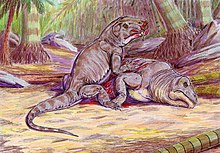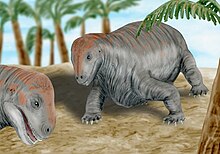Ulemosaurus
| Ulemosaurus | ||||||||||||
|---|---|---|---|---|---|---|---|---|---|---|---|---|

Ulemosaurus svijagensis |
||||||||||||
| Temporal occurrence | ||||||||||||
| Middle Perm ( Capitanium ) | ||||||||||||
| 265 million years | ||||||||||||
| Locations | ||||||||||||
|
||||||||||||
| Systematics | ||||||||||||
|
||||||||||||
| Scientific name | ||||||||||||
| Ulemosaurus | ||||||||||||
| Ryabinin , 1938 | ||||||||||||
| species | ||||||||||||
|
Ulemosaurus is an extinct genus of herbivorous dinosaurs , a taxon of basal therapsids (the so-called "mammal-like reptiles"). The fossils , which are around 265 million years old, come from the Middle Permian of Russia and are classified as part of the Ischejewo fauna. Ulemosaurus is the only known representative of the Tapinocephalids whose remains have been found outside of South Africa .
Fossil record and physique
The first description made Ryabinin 1938 from a single skull on. Other specimens are also known from skulls and various incomplete postcranial elements. In addition to a shoulder girdle , these also include a humerus , ulna and radius and some vertebrae .
The skulls reached a length of up to 30 centimeters, the total body length of the animal was approx. 3 meters. Ulemosaurus had a narrow, pointed snout, which was covered with finger-like interlocking large incisors , medium-sized canines and smaller molars. The postorbital region of the skull (behind the eyes) was very wide and high. As with all dinocephalians, the roof of the skull was thickened with pronounced pachyostosis over the eye sockets. The temple openings were relatively large for a Tapinocephalid .

Another characteristic of Ulemosaurus was the unconventional posture typical of the representatives of the Tapinocephalids . While the forelimbs were still spread apart as in the pelycosaurs , the animal already held the shorter hind legs under the hip , so that it had a posture similar to that of a modern giraffe .
Due to numerous anatomical similarities, Ulemosaurus svijagensis was initially thought to be just a new species of the South African genus Moschops . Today, however , Ulemosaurus is considered by most scientists as a separate genus, which is closely related to Moschops , but has some archaic features.
Way of life
The strongly thickened frontal bone has led to the assumption that Ulemosaurus, like other dinosaurs, also used the head as a weapon in turf and mating fights. It is also not certain whether the genus mainly lived on dry land or, as is mainly claimed in older publications, had an at least semi- aquatic way of life. However, behavior such as head-butting speaks against this assumption.
The eating habits of Ulemosaurus are also controversial. The posture of the animal suggests that it was a leaf eater . The tooth structure, however, suggests an omnivorous diet.
literature
- Michael J. Benton / Michail A. Shishkin et al.ii (Eds.): The Age of Dinosaurs in Russia and Mongolia, Cambridge University Press 2000.
Individual evidence
- ^ Riabinin, AN, 1938. Vertebrate fauna from the Upper Permian deposits of the Sviaga basin: 1. A new Dinocephalian, Ulemosaurus sviagensi n. Gen. N. Sp: Ezheg. Muz. Akad. FN Chernysheva, v. 1, p. 4-40.
